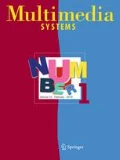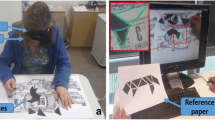Abstract
As multimedia become an integral part of collaborative systems, we must understand how to design such systems to support the user's rich set of existing interaction skills, rather than requiring people to adapt to arbitrary constraints of technology-driven designs. To understand how we can make effective use of video in remote collaboration, we compared a small team's interactions through a desktop video conferencing prototype with face-to-face interactions and phone conversations. We found that, compared with audio-only, the video channel of our desktop video conferencing prototype adds or improves the ability to show understanding, forecast responses, give nonverbal information, enhance verbal descriptions, manage pauses, and express attitudes. These findings suggest that video may be better than the phone for handling conflict and other interaction-intense activities. However, the advantages of video depend critically on the nearly-instantaneous transmission of audio, even if it means getting out of sync with the video image. Nonetheless, when compared with face-to-face interaction, it can be difficult in video interactions to notice peripheral cues, control the floor, have side conversations, point to things or manipulate real-world objects. To enable rich interactions fully, video should be integrated with other distributed tools that increase the extent and type of shared space in a way that enables natural collaborative behaviors within those environments.
Similar content being viewed by others
References
Bly SA, Harrison SR, Irwin S (1993) Media spaces: bringing people together in a video, audio, and computing environment. Commun ACM 36:28–45
Brown P, Levinson S (1978) Universals in language usage: politeness phenomena. In: Goody E (ed) Questions and politeness, Cambridge University Press, Cambrdige, pp 56–311 University Press, 1978.
Chapanis A, Ochsman RB, Parrish RN, Weeks GD (1972) Studies in interactive communication: I. The effects of four communication modes on the behavior of teams during cooperative problem-solving. Human Factors 14:487–509
Clark HH, Wilkes-Gibbs D (1986) Referring as a collaborative process. Cognition 22:1–39
Clark HH, Schaefer EF (1987) Collaborating on contributions to conversations. Language and cognitive processes 2:19–41
Duncan S (1972) Some signals and rules for taking speaking turns in conversation. J Personality Soc Psychol 23:283–292
Fish RS, Kraut RE, Chalfonte BL (1990) The videowindows system in informal communications. Proceedings of the Conference on Computer-Supported Cooperative Work, Los Angeles, Calif., pp 1–11
Fish RS, Kraut RE, Root RW (1992) Evaluating video as a technology for informal communication. Proceedings of CHI '92 Human Factors in Computing Systems, Monterey, Calif., pp 37–48
Francik E, Ehrlich Rudman S, Cooper D, Levine S (1991) Putting innovation to work: adoption strategies for multimedia communication systems. Commun ACM 34:53–63
Gale S (1990) Human aspects of interactive multimedia communication. Interacting with Computers 2:175–189
Grudin J (1988) Why CSCW applications fail: problems pn the design and evaluation of organizational interfaces. Proceedings of the Conference on Computer-Supported Cooperative Work, Portland, Ore., pp 85–93
Heath C, Luff P (1991) Disembodied conduct: communication through video in a multimedia environment. Proceedings of the CHI '91 Conference on Human Factors in Computing Systems, New Orleans, La., pp 99–103
Isaacs EA, Clark HH (1987) References in conversation between experts and novices. Journal of Experimental Psychology: General 116:26–37
Isaacs EA, Clark HH (1990) Ostensible invitations. Language in society 19:493–509
Krauss RM, Bricker PD (1967) Effects of transmission delay and access delay on the efficiency of verbal communication. J Acoustic Soc Am 41:286–292
Kraut RE, Fish RS, Root RW, Chalfonte BL (1990), Informal communication in organizations: form, function and technology. In: Oshkamp S, Spacapan S (eds) People's Reactions to Technology. Sage Publications, Newbury Park, pp 145–199
Mantei MM, Baecker RM, Sellen, AJ, Buxton, WAS, Milligan T (1991) Experiences in the use of a media space. Proceedings of the CHI '91 Conference on Human Factors in Computing Systems, New Orleans, La., pp 203–208
Ochsman RB, Chapanis A (1974), The effects of 10 communication modes on the behavior of teams during cooperative problem-solving. Int J Man-Machine Studies, 6:579–619
Olson MH, Bly SA (1991) The Portland experience: a report on a distributed research group. Int J Man-Machine Systems 34:211–228. Reprinted in: Greenberg S (ed) Computer-supported Cooperative Work and Groupware, Academic Press, London, pp 81–98
Pearl A (1992) System support for integrated desktop video conferencing. Sun Microsystems Laboratories, Inc. Technical Report, TR-92-4
Root RW (1988) Design of a multimedia vehicle for social browsing. Proceedings of the Conference on Computer-Supported Cooperative Work, Portland, Ore., pp 25–38
Sacks H, Schegloff E, Jefferson G (1974) A simplest systematics for the organization of turn-taking for conversation. Language 50:696–735
Sellen AJ (1992) Speech patterns in video-mediated conversations. Proceedings of CHI '92 Human Factors in Computing Systems, Monterey, Calif., pp 49–59
Short J, Williams E, Christie B (1976) The social psychology of telecommunications. John Wiley, London
Tang JC (1991a) Involving social scientists in the design of new technology. In: Karat J (ed) Taking software design seriously: practical techniques for human-computer interaction. Academic Press, Boston, pp 115–126
Tang JC (1991b) Findings from observational studies of collaborative work. Int J Man-Machine Studies 34:143–160. Reprinted in: Greenberg S (ed) Computer-supported Cooperative Work and Groupware, Academic Press, London, pp 11–28
Tang JC, Isaacs EA (1993) Why do users like video? Studies of multimedia-supported collaboration. CSCW: Int J 1:163–196
Tang JC, Minneman SL (1991) VideoDraw: a video interface for collaborative drawing, ACM Trans Inform Syst 9:170–184
Tatar D (1989) Using video-based observation to shape the design of a new technology. SIGCHI Bulletin 21:108–111
Whittaker S, Frohlich D, Daly-Jones O, Informal workplace communication: What is it like and how might we support it?, Proceedings of the CHI '94 Conference on Human Factors in Computing Systems, Boston, Mass., pp 131–137
Williams E (1977) Experimental comparisons of face-to-face and mediated communication: a review. Psychol Bulletin 84:963–976
Wolf CG (1982) Video conferencing: delay and transmission considerations. In: Parker LA, Olgren CH (eds) Teleconferencing and electronic communications: applications, technologies and human factors, University of Wisconsin Extension Center for Interactive Programs, Madison, Wisconsin, pp 184–188
Wulfman CE, Isaacs EA, Webber BL, Fagan LM (1988) Integration discontinuity:rfacingusersandsystems. Proceedings of Architectures for Intelligent Interfaces: Elements and Prototypes, Monterey, Calif., pp 57–68
Author information
Authors and Affiliations
Corresponding author
Rights and permissions
About this article
Cite this article
Isaacs, E.A., Tang, J.C. What video can and cannot do for collaboration: A case study. Multimedia Systems 2, 63–73 (1994). https://doi.org/10.1007/BF01274181
Issue Date:
DOI: https://doi.org/10.1007/BF01274181




